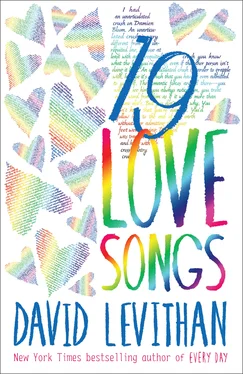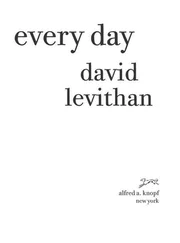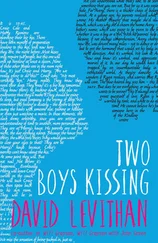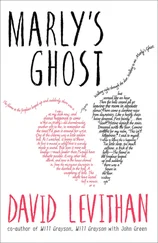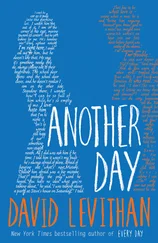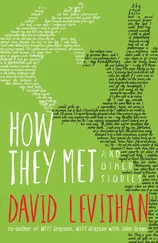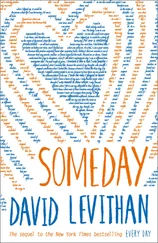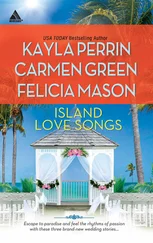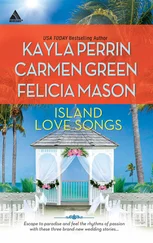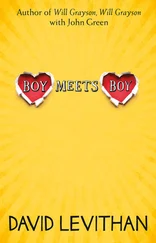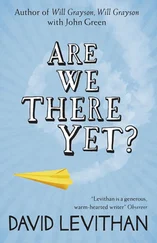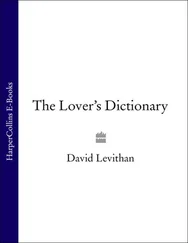I could have panicked. I could have mourned ahead of time that I was going to lose this all the next day. I was old enough to know what was going on.
But I didn’t do any of that. I let myself take it as mine. I let myself enjoy it.
I let myself believe.
We give each other gifts. Red scarves, red mittens. Cards and licorice. Upside-down pizza. We give each other gifts, but really we give each other details. When days are gone, whether they be holidays or ordinary days, when you are nowhere near where you once were, the details have a way of staying. Trips to the zoo. The decorations on a cake. We keep them. They keep us. Bedtime melodies. Constellations of construction-paper hearts. I have added them up, and in my memory, I see love.
TRACK THREE
The Good Girls
In high school, I was one of the good girls.
My parents didn’t know what to think. Every night, there’d be the parade of phone calls for their son. I’d slip out of the room, behind closed doors, to talk about friends and homework and relationships (rarely my own) and, every now and then, the meaning of life. They didn’t know all these girls’ voices like I did, so they were never really certain who was calling, or why. Either I had dozens of girlfriends or I didn’t have any at all.
The truth was most of my friends were girls. Mayling, Elana, Joanna, Carolyn, Lauren, and Marcie were the good girls. Lynda, Dvora, Rebecca, Susannah, Dina, Meg, and Jinny were the good girls who hit on the boy thing when we hit high school. Eliza, Jodi, Jordana, Jeannie, and Maryam were the good girls one grade below us. Jennifer, Sami, and Tracey were the good girls who didn’t do the group thing with us as much. There were boys, too . . . but there weren’t that many of them. The girls were the nucleus of my social life.
We didn’t talk about sex; we talked about love. We never, ever used party as a verb. Awkwardly mixed drinks and the occasional beer or wine cooler were as alcoholic as we got. Pot was a big step. Cocaine was unimaginable. We were the kids for whom VCRs had been invented. We watched When Harry Met Sally . . . over and over again and pondered its lessons like it had been filmed in Aramaic. The central question, of course, was: Can guys and girls really be friends? I liked to think I was the proof positive, because even though I fell for one of my female friends every now and then, friendship always managed to win out in the end.
It hadn’t yet occurred to me to like boys.
We good girls coveted our phrasings like they were SAT flash cards. We honed our wits like Dorothy Parker at an Algonquin lunch table. We were smart, and we knew it. We were dorks, and we knew it. But instead of hiding both things, we embraced them. We created our own form of popularity. In our town of Millburn, New Jersey, where the football team never won, this was surprisingly easy to do.
Many of the girls were in the Millburnettes, the girls’ singing group. If any of them dated, odds were that she’d date one of the Millburnaires. I myself failed my Millburnaire audition because I tried to make every song sound like “Bring Him Home” from Les Misérables . Mr. Deal, the fussy, testy diva of a chorus director, was half-appalled and half-amused. He gave me another chance, and I decided not to take it. I hadn’t wanted to wear the ultra-blue polyester Millburnaire outfit anyway.
Instead I became a Millburnette groupie. And a school musical groupie (memorably playing the one-lined doorman in Kiss Me, Kate ). I joined the fencing team—because all my friends were there, because I needed a sport for my college applications, and because at practices, some of the girls and I talked much more than we parried.
I have learned over the years that it’s decidedly uncool to say I enjoyed high school—many people are lucky to have survived it, and others who didn’t have as bad a time like to say they did. Since I was one of the good girls, I found life in high school to be . . . good. It wasn’t always easy, and it wasn’t always nice. But through it all, I felt a passive happiness that would break out sometimes into an intensely active happiness. This would usually happen in the most random ways: Mayling pulling her long sleeve to her nose and proclaiming “I am an elephant!” with the rest of us following suit; me and Lynda holding up signs to each other in the middle of the Metropolitan Opera House, since I was in the balcony and she was in the orchestra, and we couldn’t go the length of an opera without passing some word to each other; me and Jennifer leaving lunch early and sitting on the fenced-off stairway that led to the auditorium, remarking on the people who passed us and, when the hallway traffic was slow, talking about books. If we never felt the full swoon of romance, we often felt the giddy buoyancy of friendship. It was a counterbalance against all the tests we faced—tests in the classrooms, tests in the hallways, tests in what we wore and what we said and who we were.
It was a sisterhood, and I was the brother. There were some conversations I wasn’t a part of—you would think that hanging out with so many girls would open my eyes to their side of the sex thing, but with a few exceptions, this rarely came up. Instead I was exposed to the girls’ emotional landscapes, and even more important, I was allowed to have one of my own. We wore our feelings so openly—whether it was annoyance or distress or delight or anger or affection we felt. In that time and place, I wouldn’t have learned such openness from the boys. There were certainly times when everything seemed like a big traumedy . . . but I learned to deal with that. By talking it through. By talking it out. And if none of those things worked, Lynda always advised a haircut. When you wanted to change your life, she said, a haircut was often the easiest way to start.
We good girls didn’t date much, for the same reason that I didn’t clue in to my own boy thing as fast as I might have. In our somewhat small high school (with 160 or so students in our class), there weren’t that many bookish, articulate, cute, sensitive, clever, crush-worthy boys. In retrospect, I can see a couple of crushes I had without labeling them as such—tangential boys, nobody that close to me. They were usually a year or two older than I was and talked about philosophers and writers like other boys talked about sports or computers. It’s not like I dreamed of kissing them, or dating—I was just fascinated by them, mostly from afar, with occasional glimpses up close.
I also had friendship crushes—on boys and girls—but those were different; those friends I liked because of what I knew about them, not because of their mystery. I didn’t want to be their boyfriend. I wanted to be their best friend. I learned early, and learned well, that the person you talk to about the crush is much more important than the crush itself.
Instead of dating, the good girls and I were one big date-substitute. We played a lot of Pictionary. Sober Pictionary. We ruled the school newspaper and the lit mag. The B. Dalton bookstore was our favorite store in the mall, although we were never above dancing around the aisles of Kay-Bee Toys. We went into the city on weekends and waited in the half-price ticket line for Broadway shows, or went into the Village to shop for secondhand clothes. We went to museums. We rotated between Bennigan’s, T.G.I. Fridays, Chili’s, and La Strada, the local pizzeria. When we weren’t at the Morristown multiplex, we were at the Lost Picture Show in Union, which showed art films and had a roof that leaked. We read Margaret Atwood and J. D. Salinger and Kurt Vonnegut. (Some even read Ayn Rand, but I could never get into it.) We talked about art without realizing we could treat it as Art. A few of us signed our yearbooks with Sondheim lyrics.
Читать дальше
